Many people are aware that ticks exist in the world around our dogs. But you may not understand just how dangerous they can be. Ticks spread disease to humans by hitching a ride on our bodies. And they can do the same to our canine friends as well.
We want you to have the tools needed to keep your dog safe from ticks. Education around the many species of ticks in the U.S. can do just that. In this article, we discuss the 10 scariest types of ticks found on dogs. We cover the disease that ticks can spread and how to prevent them from making a home on your pet!
Let’s get started!
What Is a Tick?

A tick is a form of ectoparasites that feeds on warm-blooded hosts.
©Nitiphonphat/Shutterstock.com
We should first discuss the details of the tick itself. A tick is a form of ectoparasite that feeds on warm-blooded hosts. These critters spend their time in vegetation like grass and other long plants. They grab onto any passing host they can gain access to.
Once they find their way onto a warm-blooded host, they will then bite the skin to gain access to blood. They will typically continue to feed on their host for a few days. That’s plenty of time for them to spread dangerous diseases.
Ticks come in a variety of shapes, sizes, and colors. We want to help you better identify any tick that makes its way onto your pet’s body. We break down 10 common tick species in detail below!
Where Do You Find Ticks on Dogs?
Ticks can be found anywhere on a dog’s body, but there are a few locations they love. Some of the most common areas to find ticks on a dog’s body include:
- Between the toes
- Around the ears, on the inside and outside of the pinna
- In the armpits
- Underneath their collar
- Around the eyes
- At the base of the tail
The areas above are the most common spots, but ticks can cling onto any part of your dog’s body. If you want to check your furry friend for ticks, be sure to check his entire body.
Can Ticks Threaten My Dog’s Health?
Not only is it unpleasant to find a tick on your canine friend, but ticks can be a major threat. Ticks have the potential to spread bacterial infections to our dogs through their bite. Many of these infections can cause serious illness. If these tick-borne illnesses are not treated effectively, they can deeply impact your pet’s health. Some can even be fatal.
Some of the tick-borne diseases that we often see in dogs include:
- Lyme disease
- Anaplasmosis
- Erlichiosis
- Babesiosis
- Hepatozoonosis
- Rocky Mountain Spotted fever
- Bartonellosis
- Tick paralysis
The above illnesses can cause uncomfortable symptoms such as lethargy, weakness, anorexia, weight loss, muscle pain, diarrhea, vomiting, skin lesions, and bleeding complications. While some tick diseases can be easily treated, some of them can lead to lifelong health complications and flare ups.
Ticks may be small, but the diseases they carry pack a big punch! This is why flea and tick prevention is so important for the beloved companions in our home. Education on how dangerous these critters can be is also important.
10 Scariest Types of Ticks Found on Dogs
It’s time to introduce you to the 10 scariest ticks found on dogs. Ranging from common ticks to those found in specific corners of the country, let’s discuss them all.
The Brown Dog Tick
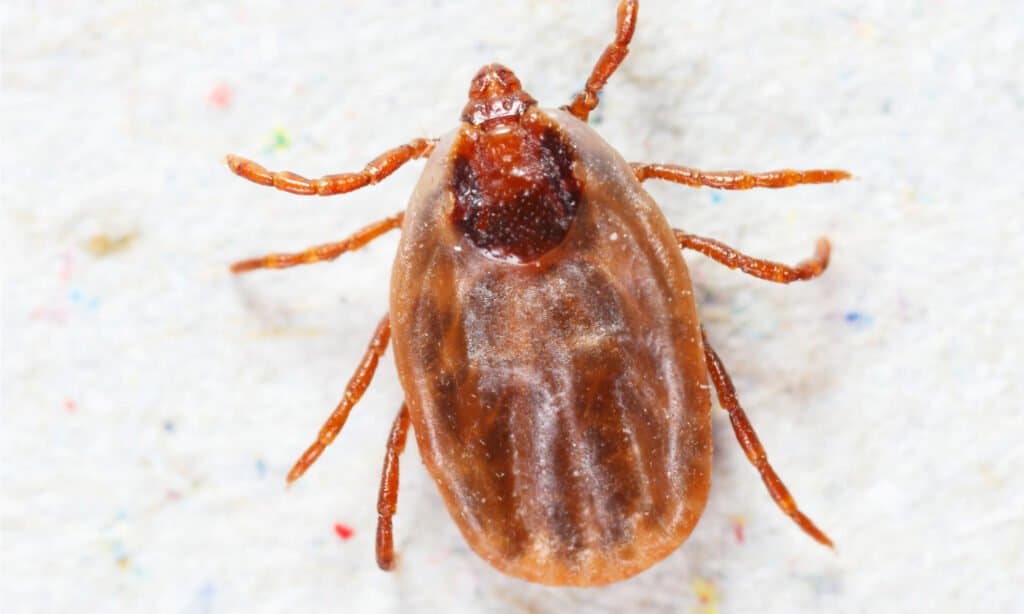
They are unique in the sense that they can complete their entire lifecycle indoors, meaning they can hide out in your home for long periods.
©7th Son Studio/Shutterstock.com
The brown dog tick, or Rhipicephalus sanguineus, is one of the most common ticks found on our furry friends. Their main host is the dog, so they can complete most of their life cycle on or around our canine friends. They are unique in the sense that they can complete their entire lifecycle indoors, meaning they can hide out in your home for long periods. They are most common in warm climates, but they can be found in any corner of the country when temperatures are mild.
The American Dog Tick
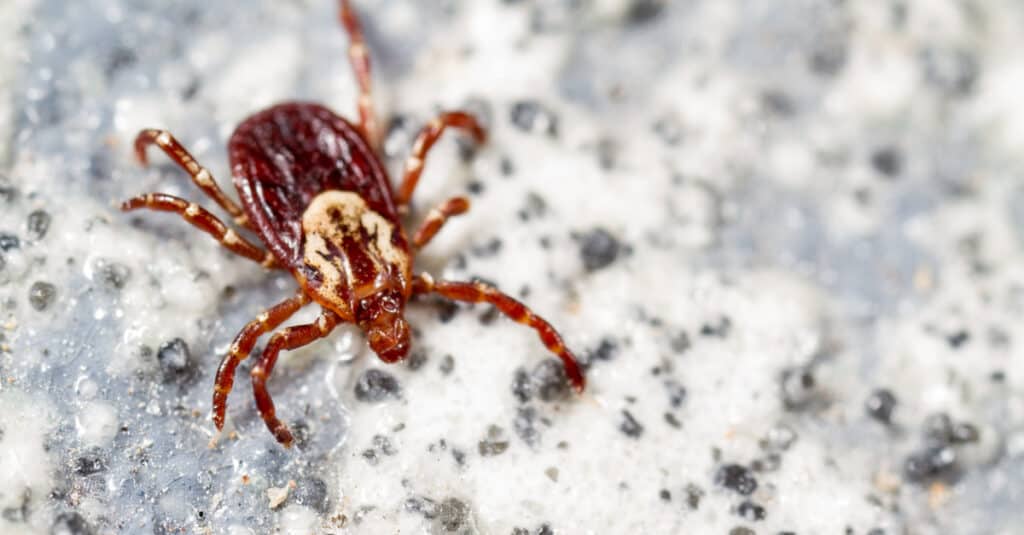
These ticks are known to spend their time in grassy areas, and they will attach themselves to any person or dog that crosses their path.
©Elliotte Rusty Harold/Shutterstock.com
The American dog tick, or Dermacentor variabilis, is a tick that is most commonly found in the Midwest, Northwest, and Eastern parts of the United States. These ticks are known to spend their time in grassy areas, and they will attach themselves to any person or dog that crosses their path. Some of the distinguishing features of this tick is the half-circle pattern on their backs, but the designs are even more unique in the male American dog ticks.
The Deer Tick
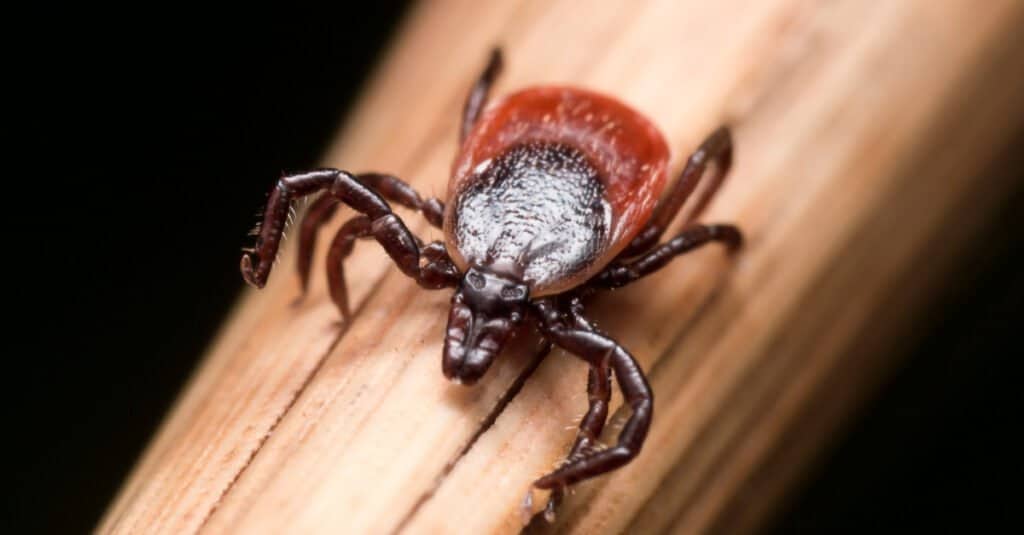
This tick is most prevalent in the midwestern and eastern regions of the U.S.
©Steven Ellingson/Shutterstock.com
The deer tick, or Ixodes scapularis, is a common tick found in wooded areas. This tick is most prevalent in the midwestern and eastern regions of the U.S., but they can thrive in many locations. They are also known for being active in cold temperatures, as long as the temperature is above freezing. These ticks also have a distinct appearance, as they are orange with a black shield.
The Asian Longhorned Tick

The
Haemophysalis longicornis, or Asian longhorned tick, is new to the United States.
©James Gathany / public domain – Original
The Asian Longhorned Tick, or Haemophysalis longicornis, is a tick that is fairly new to the United States. They were first discovered in the US in 2017, but they still appear to spend most of their time in the Eastern regions. These ticks are known to cause severe infestations, as the females do not need a male tick to reproduce. Dogs that are infected with the Asian Longhorned tick can develop severe anemia for this reason, as their tick infestation can quickly become severe.
The Lone Star Tick
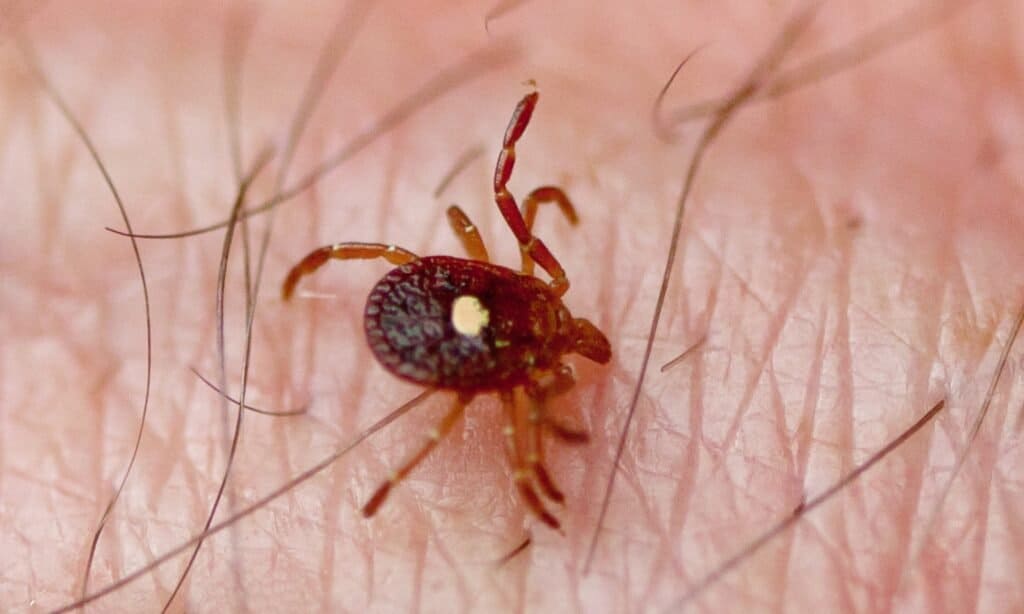
Lone star ticks are known for being much more aggressive than other species of tick.
©iStock.com/epantha
The lone star tick, or Amblyomma americanum, is a tick that is commonly found in the eastern and midwestern states of the US. They are a brown to maroon in color and have a signature white spot on their back, and this trait led to their name as the ‘Lone Star tick’. These ticks are known for being fairly aggressive and will often go out of their way to travel to their host.
The Rocky Mountain Wood Tick

Rocky Mountain wood ticks prefer living in high elevation climates, and they can be found in terrain ranging from grassy fields to wooded areas.
©South12th Photography/Shutterstock.com
The Rocky Mountain wood tick, or Dermacentor andersoni, is a tick that is commonly found in the Rocky Mountain states. They seem to prefer living in high elevation climates, and they can be found in terrain ranging from grassy fields to wooded areas. They can exist during the winter months, but they are most commonly seen during the spring. The tick itself is brown in color, but with a white to cream colored shield.
The Pacific Coast Tick
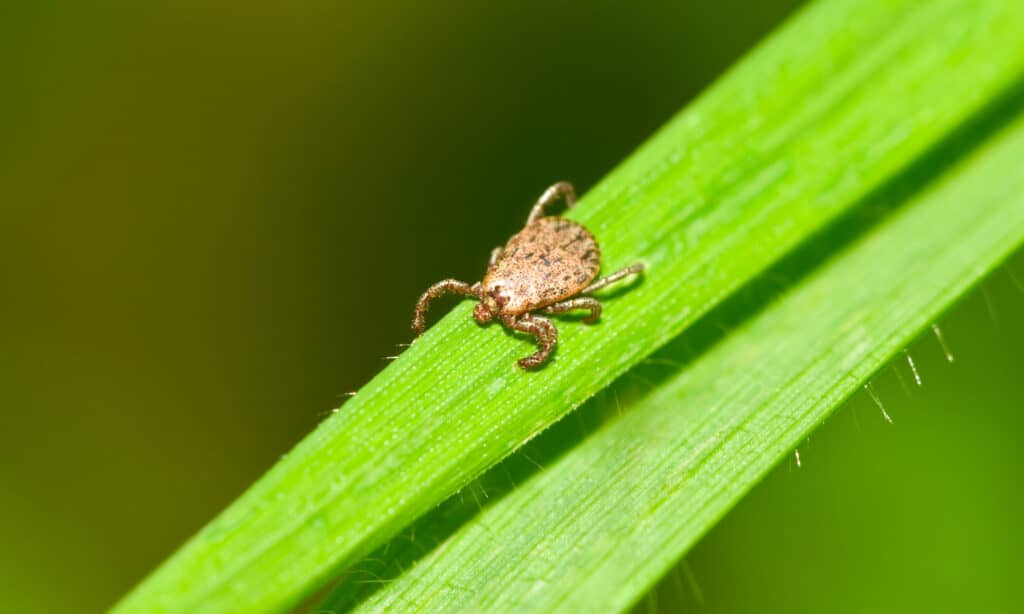
The
Dermacentor occidentalisis known for its painful bite.
©South12th Photography/Shutterstock.com
The Pacific Coast tick, or Dermacentor occidentalis, is a tick that is found throughout California and the rest of the West Coast. This tick does not stand out due to their standard brown appearance, but they have made a name for themselves in other ways. The Pacific Coast tick is known for having a very painful bite, causing many to think they were just bitten by a spider.
The Western Black Legged Tick
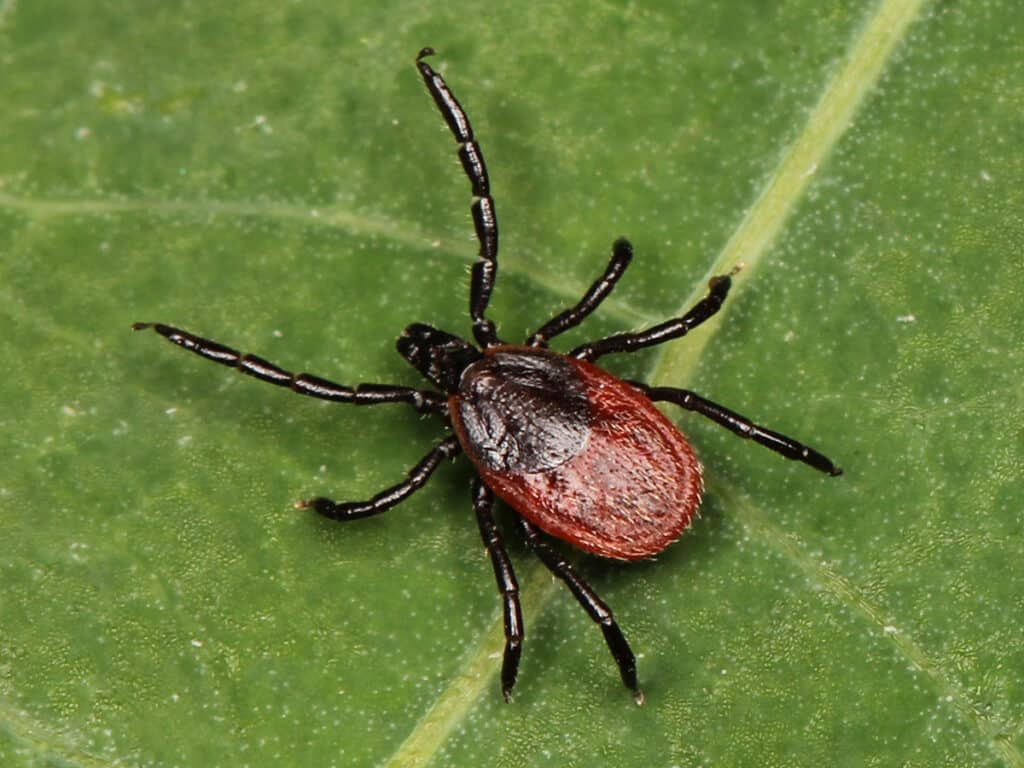
The western black legged tick is a close relative to the deer tick.
The western black legged tick, or Ixodes pacificus, is a tick that is most common in the western regions of the U.S. They live in grassy areas, and they resemble the deer tick in color. This tick has an orange body with black legs, and they can spread Lyme disease in the western regions of the country.
The Spinose Ear Tick

The spinose ear tick can cause serious inflammation of the ears in dogs.
©Mat Pound-USDA Agricultural Research Service Country-United States / Creative Commons – Original / License
The spinose ear tick, or Otobius megnini, is one of the most unique ticks on the list. They live throughout the United States, but they inhabit many parts of the world. These ticks are not parasitic in their adult stage, but they do cling onto hosts in their larval and nymphal stages. They typically inhabit their host’s ears, and often lead to severe localized inflammation and infections.
The Gulf Coast Tick

This tick is most known for spreading an illness known as ‘rickettsia parkeri rickettsiosis’, which is a bacteria.
©iStock.com/cturtletrax
The Gulf Coast tick, or Amblyomma maculatum, is a tick residing along the Gulf Coast. This tick is most known for spreading an illness known as ‘rickettsia parkeri rickettsiosis’, which is a bacteria that causes symptoms ranging from sore muscles to skin rashes. They have a brown body with unique white markings, so they are typically easy to identify.
There Is a Tick on My Dog – What Should I Do?
If you have just found a tick on your dog’s skin, then you may be wondering what you should do next. It’s always best to remove the tick from your dog’s body the moment you notice it, as leaving it on only increases the time they have to potentially spread tick-borne illness.
When you are removing a tick from your dog’s body, it’s not as easy as simply plucking it off. You always want to make sure that you are removing the head of the tick along with their body, because it is easy to accidently leave the head of the tick behind.
The best way to remove a tick from your dog’s body is by using a set of tweezers. This will allow you to grip the tick as close to the base of the skin as possible, and remove the entire portion of the tick. Just be sure that you are killing the ticks as you remove them, as they can easily crawl away and reinfect your pup when given the chance. A great way to dispose of these ticks is by placing them in a bowl with rubbing alcohol.
How Do I Know If My Dog Has Tick Disease?
You may wonder how you will know if your pet is infected with a tick-borne disease. Not all dogs will display obvious signs, so specific testing is often the only way to accurately diagnose your companion.
The process will vary based on the type of tick disease in question. The most common testing option for tick disease in dogs is a 4Dx snap test. This tests for multiple tick-borne diseases (Anaplasma, Erlichia, and Lyme).
Your vet can also send a sample of your dog’s blood to the lab for more in-depth testing. This is a common option in areas that have a high prevalence of tick disease.
Though your vet will need to perform testing to get an official diagnosis, there are some common symptoms. These include lethargy, weakness, anorexia, weight loss, muscle pain, limb swelling, diarrhea, vomiting, skin lesions, bleeding complications, and bruising. If you think your dog was exposed to a tick-borne illness, then we suggest having them assessed by your veterinarian.
How Do I Protect My Dog from Ticks?
Thankfully, there is an easy way to protect our pups against ticks and the diseases they carry. Simply speak with your vet about starting your pup on an approved monthly flea and tick prevention. This should keep dangerous ticks at bay! Just be sure to get approval from your vet if you purchase any preventative outside of your vet’s office. Some products have unknown ingredients that could impact your pet’s health.
We also recommend speaking with your vet before starting any form of flea and tick prevention. Some dogs are at risk of experiencing negative side effects. For example, some border collies or dogs with seizure disorders can experience neurological symptoms. Even if your canine friend is perfectly healthy, it’s best to get veterinary approval before starting any new medications.
Final Thoughts
As you can see, there are a variety of ticks across the United States. Ticks are opportunists that jump onto pets as they walk by. Any dog that goes outside is at risk of becoming a tick’s host. Whether your pup goes on hikes or just takes quick bathroom breaks, she can fall victim to fleas and ticks.
Due to how dangerous ticks can be, we always suggest checking your pet’s regularly for the presence of any ectoparasites. Be sure to review the information we listed above so you can properly identify ticks. And speak with your vet about monthly flea and tick prevention for your dog moving forward!
Ready to discover the top 10 cutest dog breeds in the entire world?
How about the fastest dogs, the largest dogs and those that are -- quite frankly -- just the kindest dogs on the planet? Each day, AZ Animals sends out lists just like this to our thousands of email subscribers. And the best part? It's FREE. Join today by entering your email below.
Thank you for reading! Have some feedback for us? Contact the AZ Animals editorial team.








